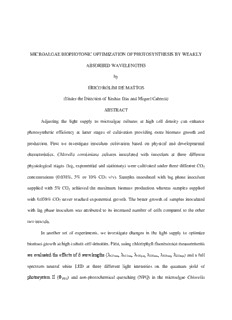Table Of ContentMICROALGAE BIOPHOTONIC OPTIMIZATION OF PHOTOSYNTHESIS BY WEAKLY
ABSORBED WAVELENGTHS
by
ERICO ROLIM DE MATTOS
(Under the Direction of Keshav Das and Miguel Cabrera)
ABSTRACT
Adjusting the light supply to microalgae cultures at high cell density can enhance
photosynthetic efficiency at latter stages of cultivation providing extra biomass growth and
production. First we investigate inoculum cultivation based on physical and developmental
characteristics. Chlorella sorokiniana cultures inoculated with inoculum at three different
physiological stages (lag, exponential and stationary) were cultivated under three different CO
2
concentrations (0.038%, 5% or 10% CO v/v). Samples inoculated with lag phase inoculum
2
supplied with 5% CO achieved the maximum biomass production whereas samples supplied
2
with 0.038% CO never reached exponential growth. The better growth of samples inoculated
2
with lag phase inoculum was attributed to its increased number of cells compared to the other
two inocula.
In another set of experiments, we investigate changes in the light supply to optimize
biomass growth at high culture cell densities. First, using chlorophyll fluorescence measurements
we evaluated the effects of 6 wavelengths (λ , λ , λ , λ , λ , λ ) and a full
627nm 617nm 590nm 530nm 505nm 470nm
spectrum neutral white LED at three different light intensities on the quantum yield of
photosystem II (Φ ) and non-photochemical quenching (NPQ) in the microalgae Chlorella
PSII
sorokiniana at three different cell densities (OD 0.5, 1.0 and 1.5). An inverted correlation
between Φ and light intensity was found across the whole experiment.
PSII
As C. sorokiniana cell density increased a decrease in Φ values measured under the
PSII
green light was observed. NPQ had a noticeable decrease under all light sources as the culture
density increased from OD 0.5 to 1.0.
To confirm the indications found in the previous experiment, in a second experiment
photosynthetic activity and biomass production induced by 4 different LEDs (λ , λ ,
470nm 530nm
λ , and white-3000K) were analyzed on high-density cultures of Scenedesmus bijuga. As
655nm
culture density increased, the weakly absorbed green light became more photosynthetically
efficient than the red light, thereby inducing significantly higher oxygen evolution at culture
concentration of 1.45 g/L. High-density culture (2.19 g/L) cultivated under the green light
showed higher biomass production rate (30 mg/L/d) with a 8.43% dry biomass growth in a 6-day
period compared to the red light that induced 4.35% dry biomass growth during the same period.
INDEX WORDS: microalgae, photosynthesis, biomass, production
ii
MICROALGAE BIOPHOTONIC OPTIMIZATION OF PHOTOSYNTHESIS BY WEAKLY
ABSORBED WAVELENGTHS
by
ERICO ROLIM DE MATTOS
BS, Universidade de Sao Paulo, Brazil, 2008
A Dissertation Submitted to the Graduate Faculty of the University of Georgia in Partial
Fulfillment of the Requirement for the Degree
DOCTOR OF PHYLOSOPHY
ATHENS, GEORGIA
2013
© 2013
Erico Rolim de Mattos
All Rights Reserved
MICROALGAE BIOPHOTONIC OPTIMIZATION OF PHOTOSYNTHESIS BY WEAKLY
ABSORBED WAVELENGTHS
by
ERICO ROLIM DE MATTOS
Major Professor: Miguel Cabrera
Committee: Keshav Das
Marc van Iersel
Mark Haidekker
Gregory Schmidt
Electronic Version Approved:
Maureen Grasso
Dean of the Graduate School
The University of Georgia
August 2013
DEDICATION
I dedicate this dissertation to my parents Alda and Jose Paulo and my brother Gustavo,
who always supported and encouraged me.
iv
ACKNOWLEDGEMENTS
I would like to express my sincerest and profound gratitude to Dr. Keshav Das for such
innate and extraordinary mentorship and guidance in my studies and in my life, allowing me to
grow up as a person and as a researcher. I will be forever grateful.
I would like to thank Dr. Miguel Cabrera for all the academic guiding and support along
my PhD.
I would like to thank Dr. Marisa d’Arce for the constant support and encouragement.
This step in my life started because of you. I would also like to thank Ryan Adolphson for his
initiative and trust which gave me the opportunity to get here. To my fellow lab mates, especially
Eric, Ronnie, Rekha and Ana I would like to acknowledge the constant entertainment, help,
knowledge and friendship. And last but not the least, I’d like to thank the faculty of my
committee, especially Dr. van Iersel, Dr. Haidekker, and Dr. Schmidt. I have learned so much
with all of you.
v
TABLE OF CONTENTS
Page
ACKNOWLEDGEMENTS .............................................................................................................v
CHAPTER
1 INTRODUCTION ..........................................................................................................1
2 LITERATURE REVIEW ...............................................................................................4
Microalgae ................................................................................................................4
Applications .............................................................................................................5
Cultivation in Photobioreactors ...............................................................................8
Photosynthetic Active Radiation............................................................................12
Photosynthesis........................................................................................................13
Efficiency of Photosynthesis..................................................................................16
Green Light ............................................................................................................18
References ..............................................................................................................21
3 EFFECTS OF INOCULUM PHYSIOLOGICAL STAGE ON THE GROWTH
CHARACTERISTICS OF CHLORELLA SOROKINIANA CULTIVATED UNDER
DIFFERENT CO2 CENCENTRATIONS ....................................................................28
Abstract ..................................................................................................................29
Introduction ............................................................................................................30
Materials & Methods ..............................................................................................32
Results & Discussion .............................................................................................35
Conclusion..............................................................................................................42
vi
References ..............................................................................................................43
Tables and Figures .................................................................................................45
Addendum ..............................................................................................................54
References ..............................................................................................................56
4 CHANGES IN CHLOROPHYL FLUORESCENCE PARAMETERS IN
DIFFERENT CHLORELLA SOROKINIANA CELL DENSITIES ............................57
Abstract ..................................................................................................................58
Introduction ............................................................................................................59
Materials & Methods .............................................................................................62
Results ....................................................................................................................65
Discussion ..............................................................................................................67
Conclusion .............................................................................................................72
References ..............................................................................................................73
Tables and Figures .................................................................................................76
5 ENHANCEMENT OF BIOMASS PRODUCTION IN SCENEDESMUS BIJUGA
HIGH DENSITY CULTURE USING WEAKLY ABSORBED GREEN LIGHT ......80
Abstract ..................................................................................................................81
Introduction ............................................................................................................82
Materials & Methods .............................................................................................84
Results & Discussion .............................................................................................89
Conclusion .............................................................................................................95
References ..............................................................................................................96
Tables and Figures .................................................................................................98
vii
6 GENERAL OVERVIEW ............................................................................................107
viii
Description:Hulatt and Thomas, 2011; Lee and Palsson, 1995). Artificial . Autotrophic algae utilize CO2 as the carbon source and relay on light energy for photosynthesis, while .. in Scenedesmus sp Journal of Phycology 9:495-506. Schenk

